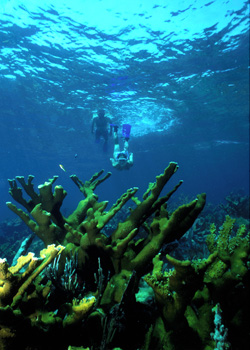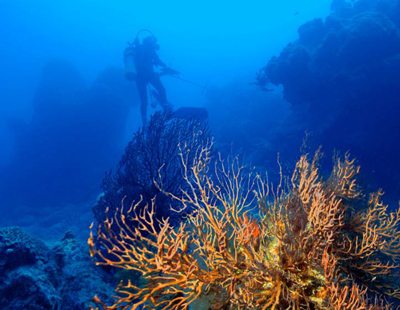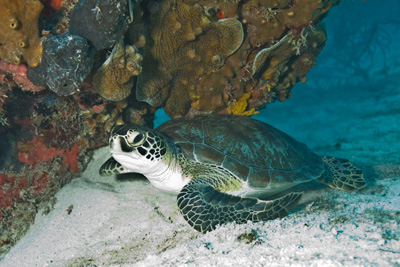
Bleaching threatens coral reefs in parks
Coral reefs are a hidden beauty found in waters around the globe.
But they are in very serious danger of disappearing within just a few decades. The National Park Service is faced with the challenge of saving 276,671 acres of reefs from countless attackers, and that’s just in the United States.
There are 10 national parks, national historical parks and national monuments that contain coral reefs in the United States, six in the Caribbean and South Florida and four in the Pacific. Biscayne National Park, Dry Tortugas National Park, U.S. Virgin Islands National Park and American Samoa are just a few examples.
| Click on the video at the right to view an audio slideshow displaying colorful coral reefs in national parks prepared by writer Alyssa Karas. Photos courtesy of the National Park Service. |
Bleaching is the primary indication of a problem in the reefs. Bleaching is the loss of zooxanthellae, or algae, through the discharge of algae from the reef or loss of algae pigmentation, thus the term “bleaching.”
This is caused by stress to the environment—anything that disturbs the coral’s ability to supply the algae with the nutrients used for photosynthesis, like carbon dioxide and ammonium. Algae and coral reefs have a mutualistic relationship, so bleaching starts a cycle that is hard to end.
In a monitoring study done at Buck Island Reef National Monument in the U.S. Virgin Islands, outbreaks of disease were found to be common after bleaching. It is believed that severe bleaching can increase vulnerability to disease.
In June, a report was released by a group of scientists that announced a shockingly small window for the impending danger facing the reefs.
| At right, the bleaching and disappearance of coral reefs, like this reef in Biscayne National Park, would negatively affect tourism and the economy (Photos courtesy of the National Park Service). Next, researchers from the National Park Service monitor the presence of coral reefs in parks like Dry Tortuga National Park. Last, many different marine species, such as the sea turtle, depend on coral reefs for protection, food and shelter. |  |
The group, which met at a workshop organized by the International Programme on the State of the Ocean (IPSO), stated that the marine species that make coral reefs could be extinct within a generation. “Unless action is taken now, the consequences of our activities are at a high risk of causing…the next globally significant extinction event in the ocean,” the report reads.
The most attention seems to be focused on the increasingly warming waters. Water that is too warm causes coral bleaching. This is caused by global warming and by the growing population of humans.
The National Park Service created a Coral Reef Community Monitoring program to observe trends in water temperature and bleaching in Biscayne National Park, Buck Island Reef National Monument, Virgin Islands National Park and Dry Tortugas National Park. When the water temperature reached a certain temperature, just above 30 degrees Celsius, there was a noticeable threshold for bleaching.
Overfishing is a problem for reefs, as the balance of the ecosystem is very important. In parks like the National Park of American Samoa, a restriction on fishing has become necessary.
 Overfishing has increased the mortality of the young fish, as they require nurturing from their parents in order to grow up healthy.
Overfishing has increased the mortality of the young fish, as they require nurturing from their parents in order to grow up healthy.
Destructive fishing practices, like using poison or explosives, are extremely treacherous for coral.
Pollution presents a large problem for reefs, as it easily leads to disease or bacterial infection.
The BP oil spill in 2010 had a shockingly destructive effect on reefs in the Gulf of Mexico.
“Oil will sit on top of the water. There’s a little plant that lives inside that needs sunlight. If it can’t get sunlight, it can’t photosynthesize. If that plant dies, the coral animal can’t survive,” Biscayne National Park Interpretive Ranger Elizabeth Edwards explained.
Runoff, sedimentation, human waste and sewage also are big problems for coral reefs.
Construction is a danger to reefs, but with a different result – immediate destruction. Coral reef is blasted with the rest of sand and marine life that happens to be an obstacle for a construction project.
The Port of Miami has plans to expand and deepen its channel as a means of competition with nearby ports and to continue to host larger ships coming and going through an expanding Panama Canal. Construction is not an issue that national parks must face, but land development near parks can have an effect on the coral reefs as well.
Many factors contribute to the distress of coral reefs and the marine life that inhabit them, and it’s most likely the combination of these factors that make such a detrimental force. The reefs are being attacked from all sides, decreasing the ocean’s overall resilience.
According to Edwards, there is one more danger, a shortage of education.
 “Just that people don’t understand that we have reefs. They don’t understand how delicate they are. It’s a lack of awareness.”
“Just that people don’t understand that we have reefs. They don’t understand how delicate they are. It’s a lack of awareness.”
The National Park Service, as a result, has set up an Inventory and Monitoring Program, whose role is to keep track of natural resources on NPS lands, including coral reefs.
This program, as well as more specific programs like the Coral Reef Community Monitoring Program, aims to identify trends and causes for the loss of coral.
The NPS often establish themselves as safe marine areas and make restrictions on fishing and water use.
It also looks to establish partnerships with programs like the National Oceanic and Atmospheric Administration in order to maximize resources. The IPSO report recommends cutting down on carbon dioxide emissions.
There is a more basic and superficial reason to take action: “the disappearance of something that is just so beautiful,” Edwards said.
The issue of protecting coral reefs is an imminent one. If nothing changes, the striking world below the surface will continue rapidly losing its luster in a matter of years.

Comments are Closed